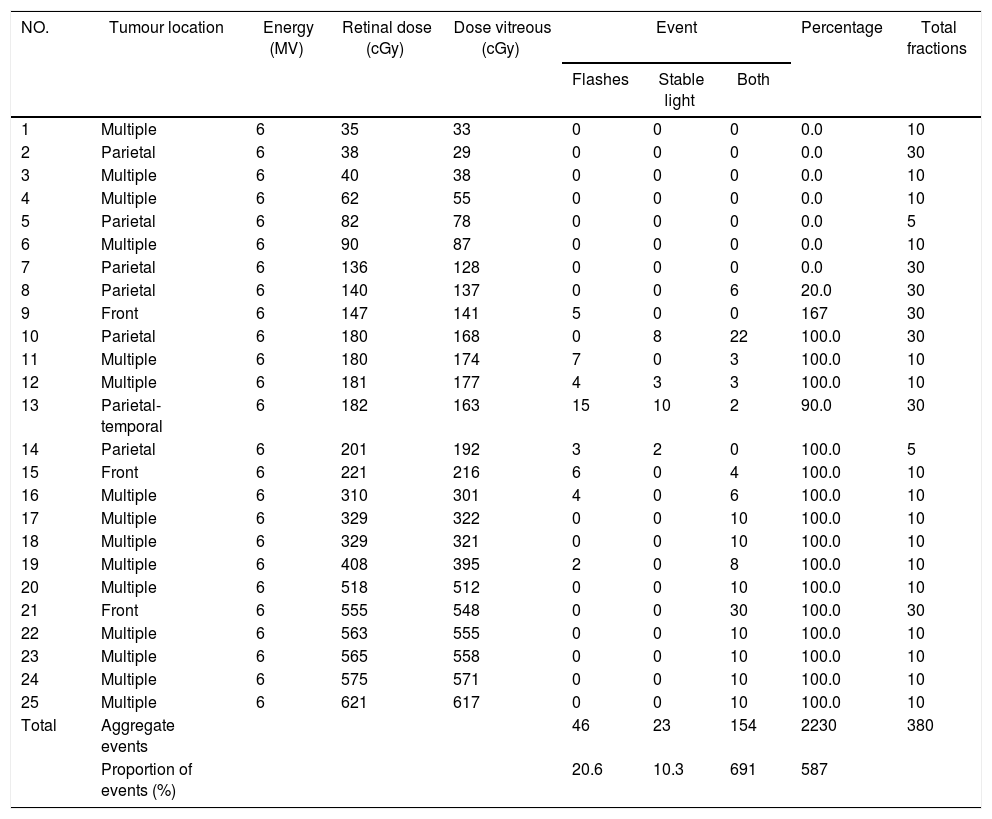Phosphenes are visual light phenomena that are experienced when there is no apparent light that stimulates the eye. In oncology, phosphenes are also present during radiation therapy for patients with tumors of the central nervous system, eyes, head and neck. Due to the discomfort of patients treated with irradiation to the head regions, research is conducted to determine whether the dose to the ocular structures is predictive for the occurrence of phosphenes. The objective was to demonstrate the relationship between the doses of the retina and vitreous humour with the appearance of phosphenes.
Material and methodA descriptive study was carried out in a prospective cohort in 25 patients older than 18 years, with malignant tumours located at the level of the brain, both of primary and secondary origin, subjected to irradiation in 6 MV linear accelerators, during February 2020 to January 2021. As independent variables: Retinal dose and vitreous humour dose, and as dependent variables: Light flashes and stable light. Logistic regression analysis was used for prediction, using the SPSS statistical program (version 26.0).
ResultA final date of 380 external radiotherapy treatments. The presence of any of the events in a prevalence of 58.7% of the total of fractions. The distribution for the presence of both events, flash of light and stable light, was 69.1%, 20.6% and 10.3% respectively. In the logistic regression analysis, for the light flare, only the dose factor in vitreous was significant (OR: 1.74, IC [1.059–2.419] p: 0.001). For stable light, the dose in the retina (OR: 1.73, IC [1.121–2.341] p: 0.005), and dose in the vitreous humor (OR: 1.82, IC [1.335–2.315] p: 0.003).
ConclusionsThere is a predictive relationship between the doses of irradiation of the retina and vitreous humour, for the generation of phosphenes. These results help radiotherapy centres take these anatomical structures into account to reduce the presence of phosphenes in patients. Likewise, it would help to reduce phosphenes, keeping the bunker area illuminated during the treatment.
Los fosfenos, son fenómenos de luz visual que se experimentan cuando no hay luz aparente que estimule el ojo. En oncología, los fosfenos también están presentes durante la radioterapia para pacientes con tumores del sistema nervioso central, ojos, cabeza y cuello. Debido a la incomodidad de los pacientes tratados con irradiación en las regiones de la cabeza, se realiza investigación para determinar si la dosis en las estructuras oculares son predicción para la ocurrencia de fosfenos. El objetivo fue demostrar la relación entre las dosis de retina y humor vítreo con la aparición de fosfenos.
Material y métodoSe realizó un estudio descriptivo, en una cohorte prospectiva en 25 pacientes mayores de 18 años, con tumores malignos localizados a nivel de encéfalo, tanto de origen primario como secundario, sometidos a irradiación en aceleradores lineales de 6 MV, durante febrero 2020 a enero del 2021. Como variables independientes: Dosis a retina y dosis a humor vítreo, y como variables dependientes: destellos de luz y luz estable. Para la predicción se utilizó el análisis de regresión logística, mediante el programa estadístico SPSS® versión 26.0.
ResultadoUna data final de 380 tratamientos de radioterapia externa. La presencia de cualquiera de los eventos en un predominio del 58.7% del total de fracciones. La distribución por la presencia de ambos eventos, destello de luz y luz estable, fue del 69,1, 20,6 y 10,3%, respectivamente. En el análisis de regresión logística, para el destello de luz, solo fue significativo el factor de dosis en vítreo (OR: 1,74, IC [1,059–2,419] p: 0.001). Para la luz estable, fueron significativos la dosis en retina (OR: 1,73, IC [1,121–2,341] p: 0,005), y dosis en humor vítreo (OR: 1,82, IC [1,335– 2,315] p: 0,003).
ConclusionesExiste una relación predictiva entre las dosis de irradiación de la retina y humor vítreo, para la generación de fosfenos. Estos resultados ayudan a que los centros de radioterapia, tomen en cuenta estas estructuras anatómicas para disminuir la presencia de fosfenos en los pacientes. Así mismo contribuiría a disminuir los fosfenos, manteniendo el área del bunker iluminado durante el tratamiento.
Artículo
Comprando el artículo el PDF del mismo podrá ser descargado
Precio 19,34 €
Comprar ahora










